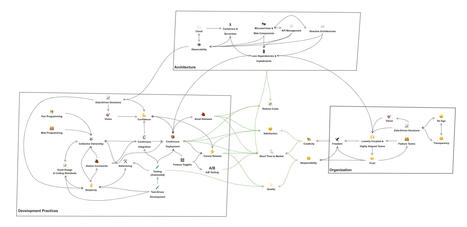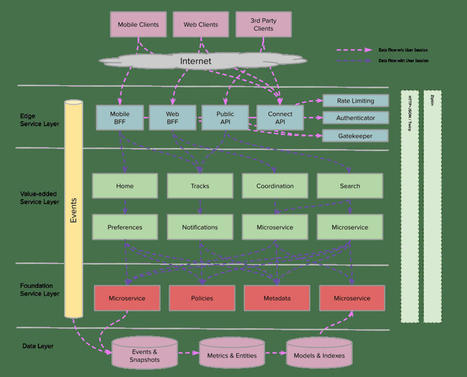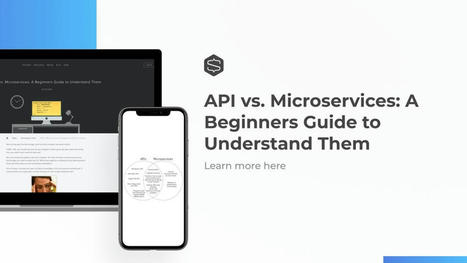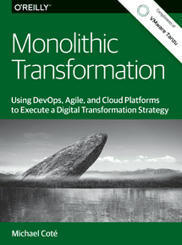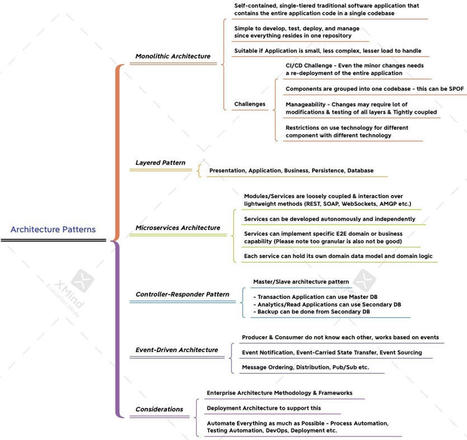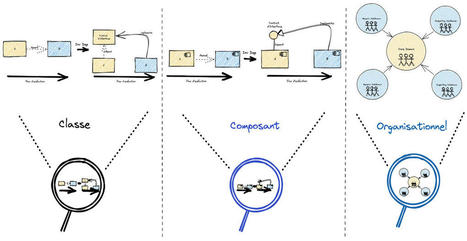Un schéma qui explique les relations entre les pratiques techniques et l'agilité.
Get Started for FREE
Sign up with Facebook Sign up with X
I don't have a Facebook or a X account

 Your new post is loading... Your new post is loading...
 Your new post is loading... Your new post is loading...
Current selected tag: 'architecture'. Clear
For innovative software organizations, managing the overall cognitive load on their teams is a guiding development and operational principle.
Mickael Ruau's insight:
The "monoliths versus microservices" debate often focuses on technological aspects, ignoring strategy and team dynamics. But instead of starting with technology, smart-thinking organizations are beginning with the team's cognitive load as the guiding principle for the effective delivery and operation of modern software systems. Excessive cognitive load works against effective team ownership and supportability of software. Here's why, and how to approach the problem.
L’architecture Microservices est puissante et populaire, et nous verrons dans cet article les bonnes et mauvaises implémentations: “petits services” vs “services découplés” ou “Lettre” vs “Esprit”.
Deux articles ont récemment été publiés par SoundCloud pour décrire l'évolution de leur architecture de service vers la mise en oeuvre de Domain Gateways, en passant par les Value-Added Services. Les auteurs décrivent comment ces patterns basés sur le Domain-Driven Design ont aidé à réduire les doublons et à homogénéiser la logique métier et le contrôle d’accès.
Key Takeaways
Mickael Ruau's insight:
Central to the microservices pattern is the concept that services must be decoupled; the end goal of the pattern is to make a distributed solution easy to develop, operate and maintain which can be easier achieved when the services are decoupled.
1) Services don’t interact directly with each other, instead they use an integration service. 2) Services are versioned.
Using an integration service (e.g. service bus) frees your microservices from depending on each other, a failure of one service shouldn’t cause the other services to fail.
Versioning shouldn’t be an afterthought in microservices, implement it at day one. If Versioning seems an overkill you’re probably prematurely ‘microservicing’ your solution.
Axway Catalyst Erik Wilde looks at how Conway’s law relates to API design and the important lessons it teaches about organizational structure and API design.
Mickael Ruau's insight:
Mel Conway formulated his famous law in 1967 and it was a reflection on how large organizations work and produce results. The “official version” (as published by Mel Conway himself) is as follows: A more informal way of putting this may be to say that “the communication paths in an organization determine the structure of the system it designs,” or even further simplifying this that “the structure of an organization determines the structure of the system it designs.” Either way, Conway’s law tells us that because designing complex systems is a complex task, it is inescapable that the way they are designed (looking at the design process as a collaborative task) determines the design that is being produced. There has been some work on testing this hypothesis in the wild, but currently, there is no “scientific proof” that this law holds. However, many believe it to have some merit. Lacking formal proof, it is up to everybody to decide for themselves whether they think that the low holds. But at the very least it can serve as an inspiration and allow us to think about the interdependencies between design processes and design outcomes.
Pour répondre à des besoins qui changent constamment, les métiers attendent de l’IT une capacité à s’adapter en temps réel aux évolutions du business. Pour offrir cette agilité, toutes les couches du système d’information doivent pouvoir s’adapter facilement, de l’infrastructure physique aux applications, de façon à ne pas remettre en cause l’architecture tous les matins. Cette agilité de bout en bout suppose un certain nombre de prérequis. Au niveau applicatif, opter pour une approche plateforme facilite les évolutions. Il faut également une industrialisation des processus IT, du développement à la mise en production, afin d’accélérer les déploiements.
These definitions might seem a bit obtuse, so here's how I would define them:
Monolith by Rene Aigner Some patterns are just about the code. If your code looks like this, and you need it to do that, here’s what to do. You’d do well to study such patterns, as they give you a …
Key Takeaways |
Flowcon online 2020
There are five key software architecture patterns in wide use. Here's what apps they're best for—and their challenges.
Mickael Ruau's insight:
Mark Richards, a software architect based in Boston, has pondered for more than 30 years about how software should work. His free book, Software Architecture Patterns, describes five architectures that are seen repeatedly in software systems. Here are Richards' five foundational architectures, distilled into a quick reference of their strengths and weaknesses, as well as optimal use cases. For many cases, one single architecture is the best choice that will unite your code. For others, it may make sense to optimize each section of code with the best architecture for it.
Part I: Fostering Change. Examine the principles of small-batch thinking, user-centric design, and shifting from functional teams to product teams.
Mickael Ruau's insight:
The best software design is simple and easy to understand. The next time you're starting a new project, instead of thinking, "How will I architect this system, what battle-tested patterns should I use and what formal methodology should I document it with?", think "How can I come up with the simplest possible design, in a way that's easy for anyone to understand?". Software architecture best practices, enterprise architecture patterns, and formalized ways to describe systems are all tools that are useful to know of and might come in handy one day. But when designing systems, start simple and stay as simple as you can. Try to avoid the complexity that more complex architecture and formal tools inherently introduce.
This blog provides various aspects that need to be considered while developing scalable and robust enterprise applications. I will discuss the following areas of enterprise applications development and considerations:
Key Takeaways
Curious observation: this is not always possible to do a transition from single to multiple deployable artifacts, or “break the monolith”. Not necessarily because “monolith” is poorly designed or implemented (this also happens, but it’s another story). The actual reason is that internal architecture might be not service-based. For example, Hexagonal Architecture is hard or impossible to refactor into service-based architecture. Another possible cause — for business reasons, it might be impossible to split domains into services. After all, applications are created to solve business problems, not vice versa.
My conference session How to Design a Good API and Why it Matters has always drawn large crowds; on InfoQ was the third most viewed content last year. When I presented this session as an invited talk at OOPSLA 2006, I was given the opportunity to write an abstract for the proceedings. In place of an ordinary abstract I decided to try something a bit unusual: I distilled the essence of the talk down to a modest collection of pithy maxims, in the spirit of Jon Bentley's classic Bumper-Sticker Computer Science, Item 6 in his excellent book, More Programming Pearls: Confessions of a Coder (Addison-Wesley, 1988).
Mickael Ruau's insight:
Watch Presentation: How to Design a Good API & Why it Matters Joshua Bloch is Chief Java Architect at Google, author of Effective Java, Second Edition (Addison-Wesley, 2008), and coauthor of Java Puzzlers: Traps, Pitfalls, and Corner Cases (Addison-Wesley, 2005) and Java Concurrency in Practice. He was a Distinguished Engineer at Sun Microsystems, where he led the design and implementation of numerous Java platform features including JDK 5.0 language enhancements and the Java Collections Framework. He holds a Ph.D. from Carnegie-Mellon and a B.S from Columbia.
At Bit, we build tools for over 100,000 developers working with components. Our tools help developers build, reuse, and collaborate on independent components to speed up development and improve…
Serverless functions are the "A" in JAMstack. However, traditional serverless functions from public clouds have poor performance, limited language and framework selections, and are generally not well suited for complex tasks such as AI inference. In this talk, we will present a new type of serverless functions, based on WebAssembly, that supports Domain Specific Languages (DSLs) specifically designed for application tasks. The WebAssembly functions are low code, very fast, and can be deployed on edge network nodes.
Extending the microservice idea to frontend development. Techniques, strategies and recipes for building a modern web app with multiple teams that can ship features independently.
Points Clés |



